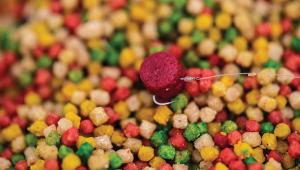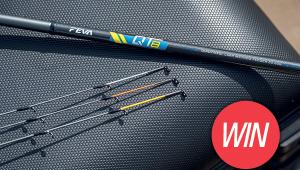Don’t Be Afraid Of The Cold

Winter is well and truly upon us now. The nights are much longer, and warm daylight (apricity, as it is officially called) is at a premium. The fish change their feeding habits rapidly with the weather, they sense the changes even quicker than we do. Yes, the first few big drops in air temperature can give them a shock, in the similar way to us being confronted by a frozen windscreen. But like we do, they get used to it very quickly. By modifying a few things, and constantly making those little tweaks each time things get that bit cooler you can still continue catching plenty of fish and stay ahead of the game in match fishing circumstances.
I’m at Makins Fishery today, which is now an amazing place once again thanks to a lot of investment and hard work from the new management and owners. It is a fishery that is fished all year round by pleasure and match anglers alike, so it responds well if approached correctly.
Reading The Swim
Lake 4 is the perfect lake to demonstrate how important it is to cover all the different depth options. In my swim I have a nice 5ft ledge on five metres, and then it drops away another 16 inches a section further out. These are great areas and often complement each other, because if the fish are not on the shallow ledge, they can be just down the next step in the deeper water. However, the nearer swim can often be great to pick off big fish that have crept up the ledge later in the session. These two lines are very close together but feeding both sparingly really does work early on in the autumn/winter period. I think that a lot of the feed from the shorter line ends up getting wafted down the ledge anyway. This is what I call my double shelf trick.
I will also look to feed a pole line as far out into the lake as suits the weather conditions. At 13.5 metres I have the main depth of the lake, which is around 10 feet deep. When fish back off in clear water they will often hang around at two-thirds depth in the deepest part. When they sit like this they can often be enticed down to feed if you don’t go mad. A small amount of your chosen baits at the start, and then topping up even smaller amounts through a constant feed pot is the ideal way. This is the distance where they feel safe, so it is so important not to push the line until they are completely ready to feed. It will benefit from being fed and left alone for as long as possible.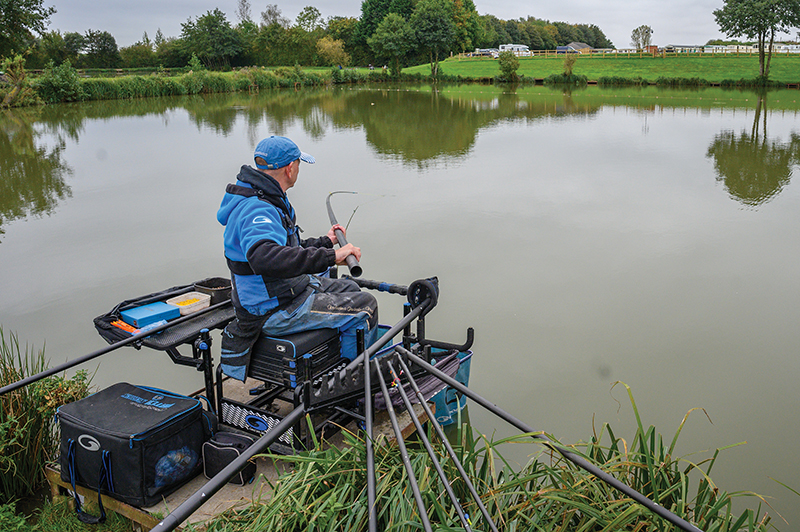 My final line is a margin line, and on this side of the lake they are very deep at about three and half feet very close in. This is good because the fish get used to coming close in all weathers as the depth gives them some protection. But beware, you often don’t get a sign that there is a fish there.
My final line is a margin line, and on this side of the lake they are very deep at about three and half feet very close in. This is good because the fish get used to coming close in all weathers as the depth gives them some protection. But beware, you often don’t get a sign that there is a fish there.
Carp will still come into the margins in all weathers but it can be a very late show. The last 10 minutes can still be worth two big lumps to make all the difference in a very tight match.
Working The Swims
Rotation is key in clearer water and colder temperatures. By splitting the match up into segments you can hopefully fill your day with catching odd fish from each of the lines. Often the short line can be good for an odd fish, then as they back off they need resting. That’s where the longer line comes in for the first visit. For me today this line wasn’t prolific, but there were always some F1s to be caught here. This gave me time to rebuild the deeper double shelf line back up where the carp preferred to be. Banded 6mms were the best hook baits by far on the day.
The double shelf lines were fed with a constant feed pot when it was tricky, but when the fish moved in well later in the session, accurately throwing three 6mms on top of the float really worked well. 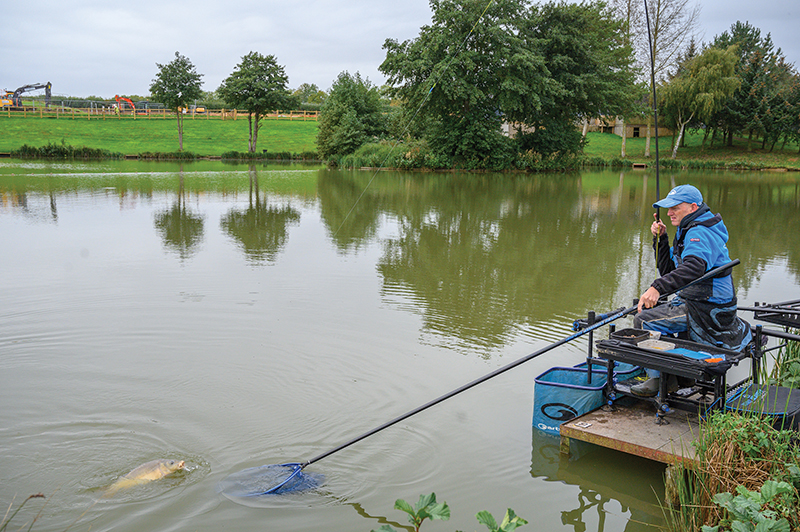
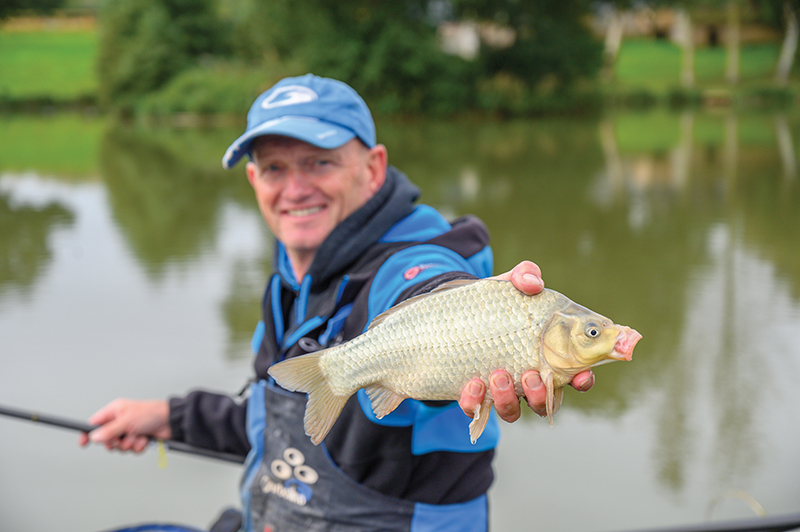 You often have to work really hard on the margin swim in winter. The main reason is that you must not go mad with bait, and to trickle small amounts of feed in regularly demands patience and time, which can hopefully reap rewards. If you don’t ever expect too much of your margins in winter they can sometimes throw up some lovely surprises, especially if you are the only one nurturing them well enough.
You often have to work really hard on the margin swim in winter. The main reason is that you must not go mad with bait, and to trickle small amounts of feed in regularly demands patience and time, which can hopefully reap rewards. If you don’t ever expect too much of your margins in winter they can sometimes throw up some lovely surprises, especially if you are the only one nurturing them well enough.
Bait Choice And Feed Options
One of the plus points of winter fishing is that it tends to reduce your bait options dramatically. Pellets, maggots and corn are probably the most important, but on many fisheries dobbed bread and meat in moderation can be superb. Meat in particular has always caught me a lot of fish in winter. It is the perfect hook bait whether fishing the pole, feeder or bomb. One trick I use is to add a small amount of Mainline Sweet Marine groundbait to coat it and give it a bit more scent and leakage. The groundbait wicks the fat out of it, which also adds to the attraction. It’s the perfect texture for winter, very soft and relatively easy to digest even in cold water. However, I won’t feed much of it unless the weather is warm, which it has been today. But don’t be afraid to try meat as an alternative hook bait over pellets or with corn. It always seems to pick a few better fish out even on the coldest days.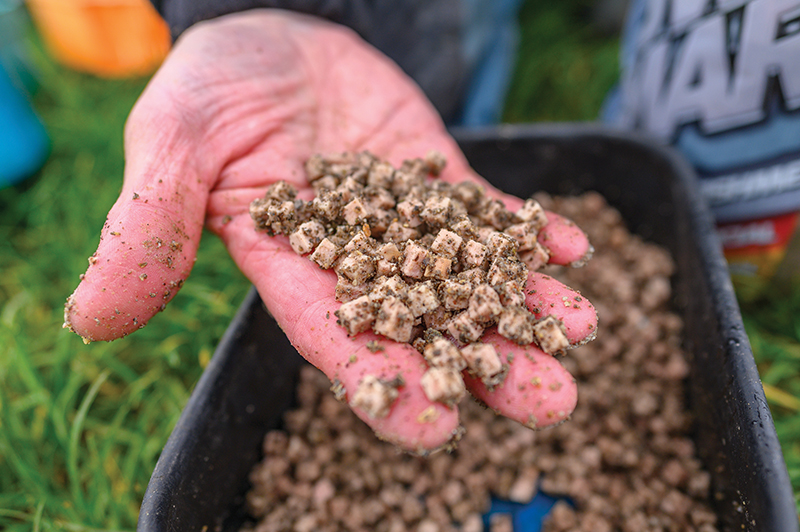
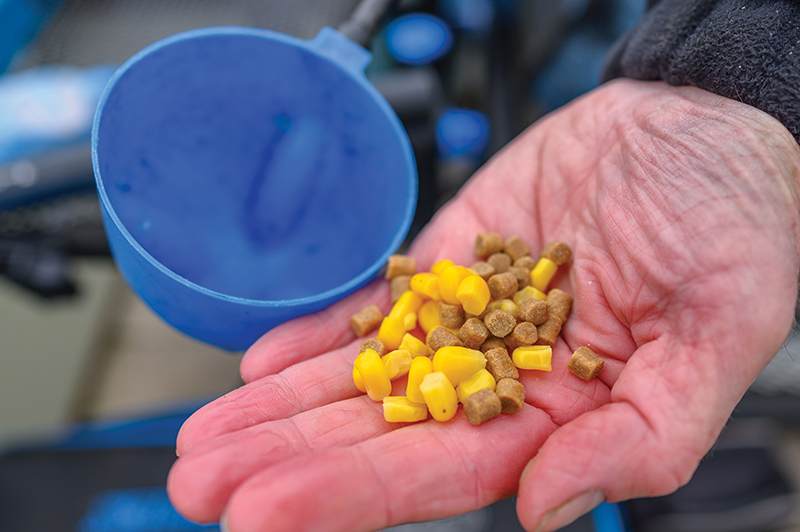 For carp and F1s the pellet and corn combo is always good, but again it’s all about moderation and knowing what is best. My general rule is 6mm hard pellets with a tiny amount of corn for carp, and micros, 4mm hard pellets and expanders for F1s. The F1s were a big but welcome surprise for me today on Lake 4 as they were only recently stocked.
For carp and F1s the pellet and corn combo is always good, but again it’s all about moderation and knowing what is best. My general rule is 6mm hard pellets with a tiny amount of corn for carp, and micros, 4mm hard pellets and expanders for F1s. The F1s were a big but welcome surprise for me today on Lake 4 as they were only recently stocked.
Always remember in winter to feed to response, don’t ever push it with feed as it is really not required at all in cold water conditions. Leave just enough bait in the swim to encourage the fish to feed. Constant feed pots rule most of the time too.
Simple Rigs Only
I like to err on the ‘lighter is better’ side if can get away with it when it comes to rigs. This obviously depends on the weather, and it is important not to compromise your presentation for this.
As I said previously for the ‘long deep’ line I fish as far away from the disturbance that the weather conditions allow. I love to fish a banded 6mm hard pellet on this line. It seems a very positive way, but fish eat them in all weathers; you don’t need to feed much at all. A small feed pot is usually the best way for accuracy and keeping everything tight. The 6mm pellets are also great for presentation. They help anchor up light rigs even in deep water for brilliant presentation. I prefer to use a stable wire stem float with a 2mm hollow bristle for carp. The Garbolino DC C13 is perfect for this in 0.40 to 0.60g. For F1s I tend to drop down an antenna size and opt for the very similar DC C12 but with a thinner 1.2mm hollow antenna. This is a better bristle to fish expanders and maggots on the hook. If it’s a bagging day on carp I will swap to a Garbolino DC C45 with a thicker bristle and carbon stem. In this deep water I will use a bulk or strung out bulk for rigs of 0.40g and above. If I am using hard pellets I always prefer to hook the band rather than use a hair rig. It is a much more positive way of fishing and I believe I hit more bites due to being tighter on the hook bait.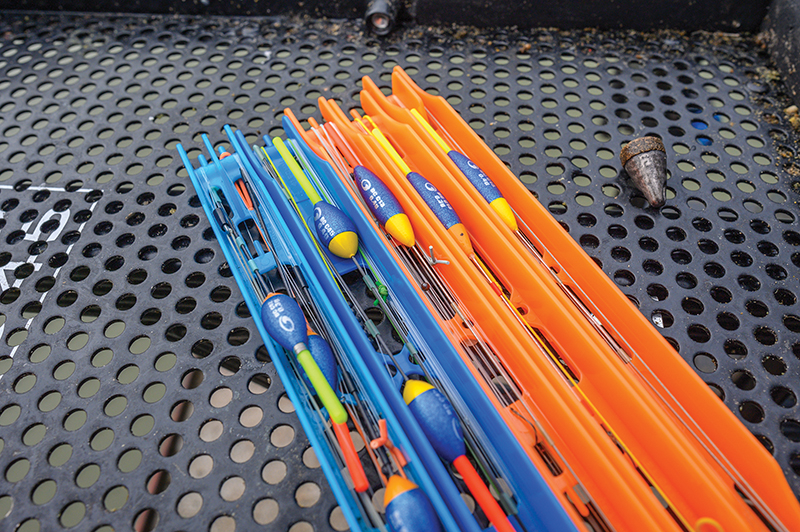
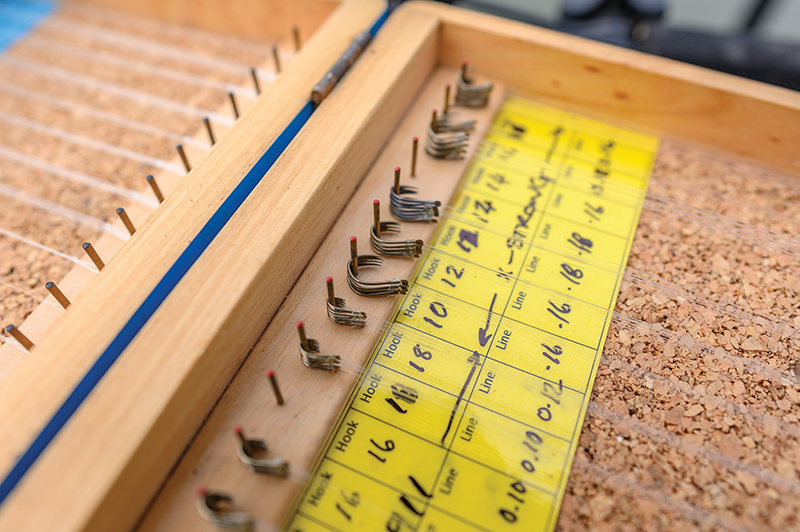 The ‘double shelf’ rigs are made up with a strung out bulk two-thirds down the line towards the hooklength. Again this creates a positive but nice falling rig, especially on 0.30g and 0.40g rigs. My choice of floats again is the DC C13. All rig lines for the above are 0.18mm Garbo Super Soft line with 0.14mm hooklengths and size 16 or 18 Guru SLWG hooks. Elastics are Super Soft Fighter in 2.1mm and 2.3mm for carp. If F1s are the target then I will often scale down on hook wires and opt for a B911 F1 tied to 0.12mm. I will marry this with 1.8mm or 2.1mm Super Soft elastics.
The ‘double shelf’ rigs are made up with a strung out bulk two-thirds down the line towards the hooklength. Again this creates a positive but nice falling rig, especially on 0.30g and 0.40g rigs. My choice of floats again is the DC C13. All rig lines for the above are 0.18mm Garbo Super Soft line with 0.14mm hooklengths and size 16 or 18 Guru SLWG hooks. Elastics are Super Soft Fighter in 2.1mm and 2.3mm for carp. If F1s are the target then I will often scale down on hook wires and opt for a B911 F1 tied to 0.12mm. I will marry this with 1.8mm or 2.1mm Super Soft elastics.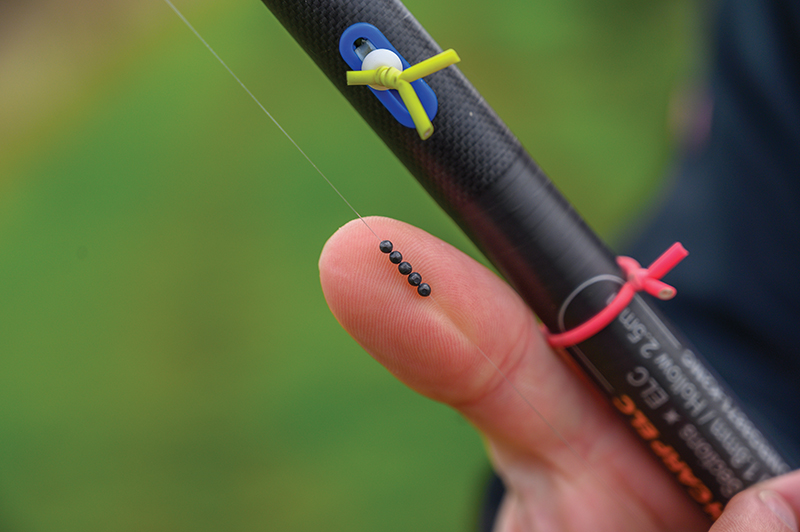
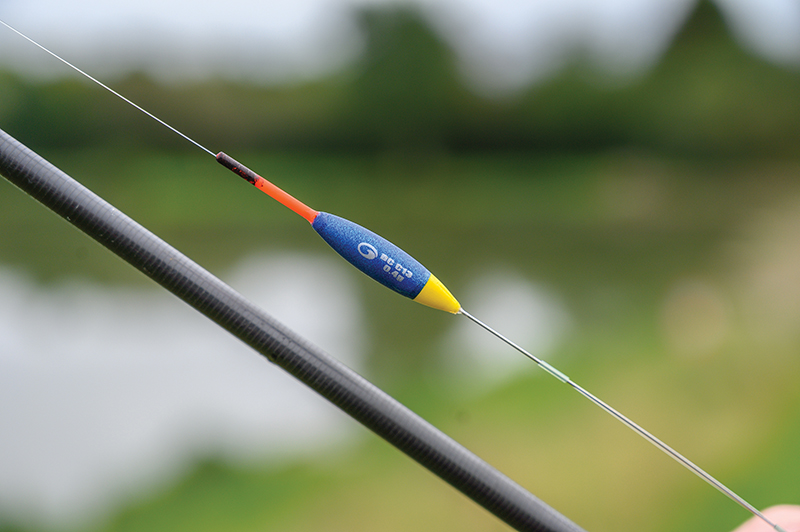 Margin rigs don’t vary much in my trays. I figure that if the fish are in the edge, they are only there for one reason, which is to feed. I will always start on a big strong hook and line for carp. I use the Garbolino Power Carp in sizes 12 or 14 and tied to a minimum of 0.16mm Super Soft, and 0.20mm rig line. I do drop down in elastics as I feel I don’t need to rush big fish, they don’t pull as hard in the cold and usually come in quite easily. The softer 2.3mm elastic helps this.
Margin rigs don’t vary much in my trays. I figure that if the fish are in the edge, they are only there for one reason, which is to feed. I will always start on a big strong hook and line for carp. I use the Garbolino Power Carp in sizes 12 or 14 and tied to a minimum of 0.16mm Super Soft, and 0.20mm rig line. I do drop down in elastics as I feel I don’t need to rush big fish, they don’t pull as hard in the cold and usually come in quite easily. The softer 2.3mm elastic helps this.
Today has been a great day with lots of fish feeding in the warm spell. It has still been a good day to demonstrate the effectiveness of rotating all lines without hammering them too much at any one point in the session. That way there are always still a few fish there should you need to drop back on that line later in the session. If you remember these few rules and apply them to your winter carp fishing, I hope you will experience a constant improvement in your catch rate.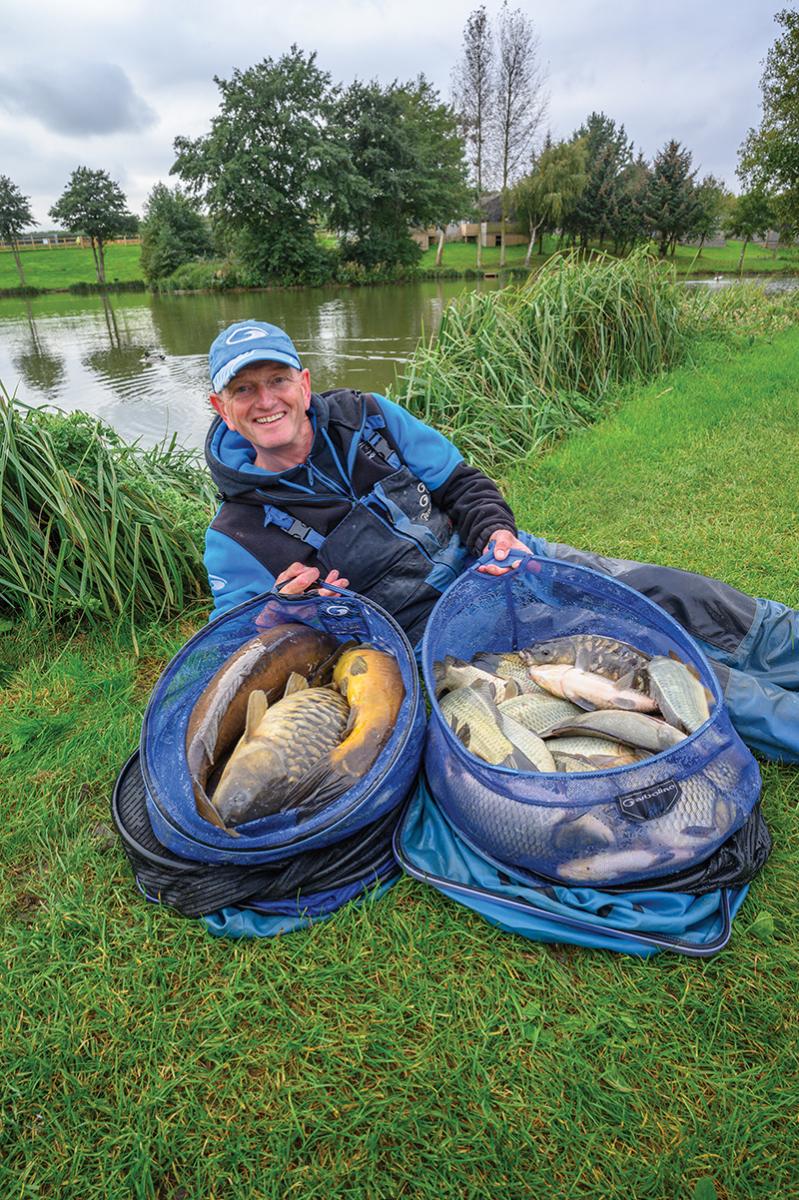
- Log in or register to post comments





